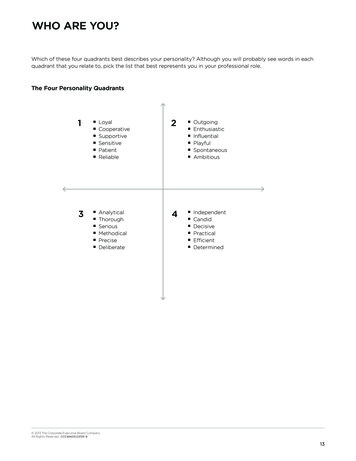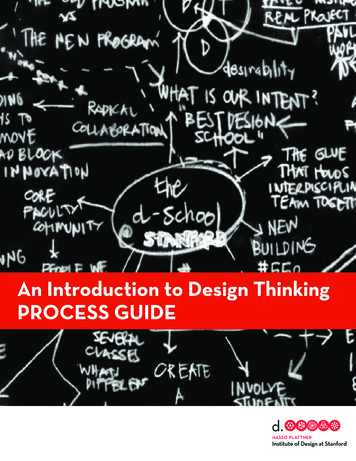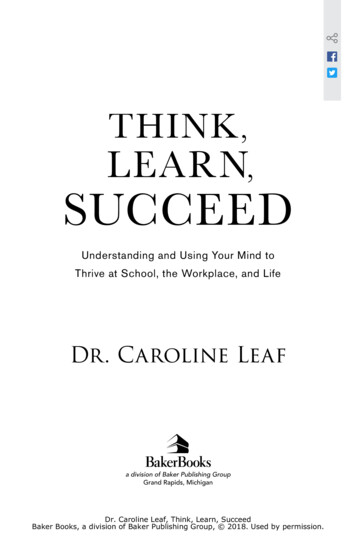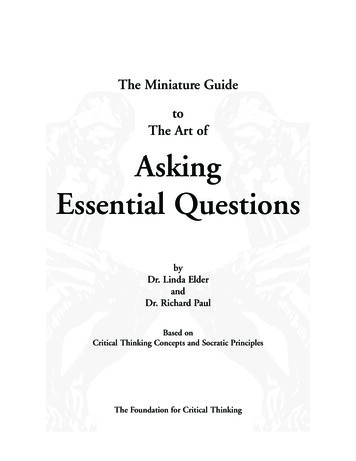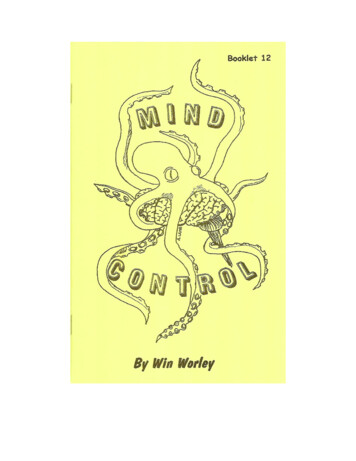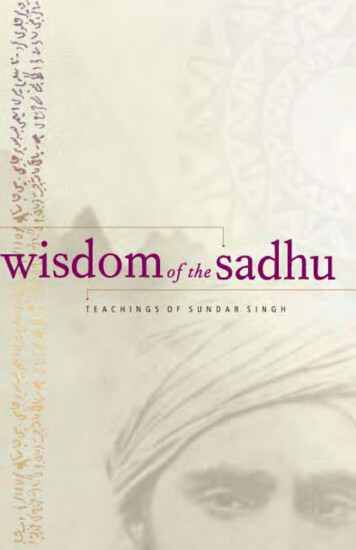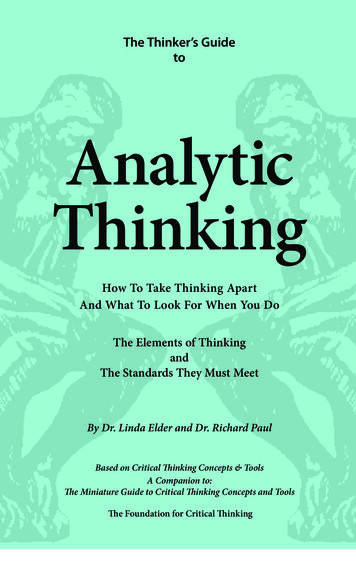
Transcription
sample download copyThe Thinker’s GuidetoAnalyticThinkingHow To Take Thinking ApartAnd What To Look For When You DoThe Elements of ThinkingandThe Standards They Must MeetBy Dr. Linda Elder and Dr. Richard PaulBased on Critical Thinking Concepts & ToolsA Companion to:The Miniature Guide to Critical Thinking Concepts and ToolsThe Foundation for Critical ThinkingClient:Foundation for Critical ThinkingProject Title:Analytic Thinking Guide 2007 (07-051)Proof 1Proof 2Proof 3Proof 49/28 11:40a10/2 11:10a10/2 2:25p10/3 10:15a
sample download copy2The Thinker’s Guide to Analytic Thinking3The Thinker’s Guide to Analytic ThinkingContentsPart 3: Using Analysis to Figure Out the Logic of AnythingPart I: Understanding the Basic Theory of AnalysisThis section provides the foundational theory essential to analysis. It delineatesthe eight basic structures present in all thinking.Why a Guide on Analytic Thinking? 4Why the Analysis of Thinking is Important 5All Thinking is Defined by the Eight Elements That Make It Up 5All Humans Use Their Thinking To Make Sense of the World 6To Analyze Thinking We Must Learn to Identify and Question Its Elemental Structures 7To Evaluate Thinking, We Must Understand and Apply Intellectual Standards 8–9Thirty-five Dimensions of Critical Thought 10–11On the Basis of the Above We Can Develop A Checklist for Evaluating Reasoning 12–13The Spirit of Critical Thinking 22Analyzing the Logic of Human Emotions 23–25Analyzing Problems 26–27Analyzing the Logic of an Article, Essay, or Chapter 28–31Analyzing the Logic of a Textbook 32Evaluating an Author’s Reasoning 33Analyzing the Logic of a Subject: 34 Science 35 History 36 Sociology 37 Economics 38–39 Ecology 40–41Part 4: Taking Your Understanding to a Deeper LevelPart 2: Getting Started: Some First StepsThis section enumerates the most important foundational moves in analysis.Think About Purpose 14State the Question 15Gather Information 16Watch Your Inferences 17Check Your Assumptions 18Clarify Your Concepts 19Understand Your Point of View 20Think Through the Implications 21 2007 Foundation for Critical ThinkingThis section provides a range of sample analyses (as well as templatesfor analysis).www.criticalthinking.orgThis section explains the elements more comprehensively, differentiating skilledfrom unskilled reasoners.Analyzing and Assessing: Goals, Purposes, or Objectives 42 Questions, Problems, and Issues 43 Data, Evidence, Experience, Research 44 Inferences, Interpretations, and Conclusions 45 Assumptions and Beliefs 46 Concepts, Ideas, and Theories 47 Points of View and Perspectives 48 Implications and Consequences 49Distinguishing Between Inferences and Assumptions 50–51Conclusion 52 2007 Foundation for Critical Thinkingwww.criticalthinking.org
sample download copy4The Thinker’s Guide to Analytic ThinkingWhy a Guide on Analytic Thinking?Analysis and evaluation are recognized as crucial skills for all students to master. Andfor good reason. These skills are required in learning any significant body of content ina non-trivial way. Students are commonly asked to analyze poems, mathematical formulas, biological systems, chapters in textbooks, concepts and ideas, essays, novels, andarticles—just to name a few. Yet how many students can explain what analysis requires?How many have a clear conception of how to think it through? Which of our graduatescould complete the sentence: “Whenever I am asked to analyze something, I use thefollowing model: ”The painful fact is that few students have been taught how to analyze. Hence, whenthey are asked to analyze something scientific, historical, literary, or mathematical—letalone something ethical, political, or personal—they lack a model to empower them inthe task. They muddle through their assignment with only the vaguest sense of whatanalysis requires. They have no idea how sound analysis can lead the way to soundevaluation and assessment. Of course, students are not alone. Many adults are similarlyconfused about analysis and assessment as intellectual processes.Yet what would we think of an auto mechanic who said, “I’ll do my best to fix yourcar, but frankly I’ve never understood the parts of the engine,” or of a grammarian whosaid, “Sorry, but I have always been confused about how to identify the parts of speech.”Clearly, students should not be asked to do analysis if they do not have a clear model,and the requisite foundations, for the doing of it. Similarly, we should not ask studentsto engage in assessment if they have no standards upon which to base their assessment.Subjective reaction should not be confused with objective evaluation.To the extent that students internalize this model through practice, they putthemselves in a much better position to begin to think historically (in their historyclasses), mathematically (in their math classes), scientifically (in their science classes),and therefore more skillfully (in all of their classes). When this model is internalized,students become better students because they acquire a powerful “system-analyzingsystem.”This thinker’s guide is a companion to The Miniature Guide to Critical ThinkingConcepts and Tools. It supports, and is supported by, all of the other miniature guidesin the series. It exemplifies why thinking is best understood and improved when we areable to analyze and assess it EXPLICITLY. The intellectual skills it emphasizes are thesame skills needed to reason through the decisions and problems inherent in any andevery dimension of human life.5The Thinker’s Guide to Analytic ThinkingWhy the Analysis of Thinkingis ImportantEveryone thinks; it is our nature to do so. But much of our thinking, left to itself, isbiased, distorted, partial, uninformed, or downright prejudiced. Yet the quality of ourlife and of what we produce, make, or build depends precisely on the quality of ourthought. Shoddy thinking is costly, both in money and in quality of life. If we want tothink well, we must understand at least the rudiments of thought, the most basic structures out of which all thinking is made. We must learn how to take thinking apart.All Thinking Is Defined by the Eight Elements That Make It UpEight basic structures are present in all thinking: Whenever we think, we think for apurpose within a point of view based on assumptions leading to implications and consequences. We use concepts, ideas and theories to interpret data, facts, and experiencesin order to answer questions, solve problems, and resolve issues. Thinking, then:ngenerates purposesnraises questionsnuses informationnutilizes conceptsnmakes inferencesnmakes assumptionsngenerates implicationsnembodies a point of viewPoint of Viewframe of reference,perspective,orientationImplications andConsequencesAssumptionspresupposition,taking for ptstheories,definitions, axioms,laws, principles,modelsQuestion at issueproblem, issueInformationdata, facts,observations,experiencesInterpretationand Inferenceconclusions,solutionsEach of these structures has implications for the others. If you change your purposeor agenda, you change your questions and problems. If you change your questions andproblems, you are forced to seek new information and data. If you collect new informationand data Essential Idea: There are eight structures that define thinking. Learning to analyzethinking requires practice in identifying these structures in use. 2007 Foundation for Critical Thinkingwww.criticalthinking.org 2007 Foundation for Critical Thinkingwww.criticalthinking.org
sample download copy6The Thinker’s Guide to Analytic ThinkingAll Humans Use Their Thinking ToMake Sense of the WorldThe words thinking and reasoning are used in everyday life as virtual synonyms.Reasoning, however, has a more formal flavor. This is because it highlights the inference-drawing capacity of the mind.Reasoning occurs whenever the mind draws conclusions on the basis of reasons. Wedraw conclusions whenever we make sense of things. The result is that whenever wethink, we reason. Usually we are not aware of the full scope of reasoning implicit in ourminds.We begin to reason from the moment we wake up in the morning. We reasonwhen we figure out what to eat for breakfast, what to wear, whether to make certainpurchases, whether to go with this or that friend to lunch. We reason as we interpretthe oncoming flow of traffic, when we react to the decisions of other drivers, whenwe speed up or slow down. One can draw conclusions, then, about everyday events or,really, about anything at all: about poems, microbes, people, numbers, historical events,social settings, psychological states, character traits, the past, the present, the future.By reasoning, then, we mean making sense of something by giving it some meaningin our mind. Virtually all thinking is part of our sense-making activities. We hearscratching at the door and think, “It’s the dog.” We see dark clouds in the sky and think,“It looks like rain.” Some of this activity operates at a subconscious level. For example,all of the sights and sounds about us have meaning for us without our explicitlynoticing that they do. Most of our reasoning is unspectacular. Our reasoning tends tobecome explicit only when someone challenges it and we have to defend it (“Why doyou say that Jack is obnoxious? I think he is quite funny”). Throughout life, we formgoals or purposes and then figure out how to pursue them. Reasoning is what enablesus to come to these decisions using ideas and meanings.On the surface, reasoning often looks simple, as if it had no component structures.Looked at more closely, however, it implies the ability to engage in a set of interrelatedintellectual processes. This miniature guide is largely focused on making these intellectual processes explicit. It will enable you to better understand what is going on beneaththe surface of your thought.To Analyze Thinking We Must Learn to Identify andQuestion its Elemental Structures8to answer aquestion orsolve aproblem.7based onconcepts andtheories6to makeinferences andjudgementsWe usedata, facts,and experiences7 2007 Foundation for Critical Thinkingwww.criticalthinking.orgWheneverwe thinkwe think for apurpose481within apoint of viewbased onassumptionsWhat is myfundamentalpurpose?UniversalStructuresof Thought6 What are mymost fundamentalinferences orconclusions?Whatinformationdo I need toanswer myquestion?23leading toimplications andconsequences.5What is thekey question Iam trying toanswer?What isthe most basicconcept in thequestion?1UniversalStructuresof Thought5Essential Idea: Reasoning occurs when we draw conclusions based on reasons.We can upgrade the quality of our reasoning when we understand the intellectualprocesses that underlie reasoning.7The Thinker’s Guide to Analytic Thinking2What is mypoint of viewwith respect tothe issue?Whatassumptions amI using in myreasoning?3Whatare theimplicationsof my reasoning(if I am correct)?4Be aware: When we understand the structures of thought, we ask important questions implied by these structures. 2007 Foundation for Critical Thinkingwww.criticalthinking.org
sample download copy26The Thinker’s Guide to Analytic ThinkingAnalyzing ProblemsIdentify some problem you need to reasonthrough. Then complete the following:What exactly is the problem? (Study the problem to make clear the kindof problem you are dealing with. Figure out, for example, what sortsof things you are going to have to do to solve it. Distinguish problemsover which you have some control from problems over which youhave no control. Pay special attention to controversial issues in whichit is essential to consider multiple points of view.)The key question that emerges from the problem is (State the question asclearly and precisely as you can. Details are very important.)My purpose in addressing the problem is (Know exactly what you areafter. Make sure you are not operating with a hidden agenda and thatyour announced and real purposes are the same.)Actively seek the information most relevant to the question. (Includein that information options for action, both short-term and long-term.Recognize limitations in terms of money, time, and power.)Some important assumptions I am using in my thinking are (Figure outwhat you are taking for granted. Watch out for self-serving or unjustifiedassumptions.)If we solve this problem, some important implications are If we failto solve this problem, some important implications are (Evaluateoptions, taking into account the advantages and disadvantages of possibledecisions before acting. What consequences are likely to follow from this orthat decision?)The most important concepts, theories, or ideas I need to use in my thinking are (Figure out all significant ideas needed to understand andsolve the problem. You may need to analyze these concepts. Use a gooddictionary.)The point(s) of view is/are as follows: (Know the point of view from whichyour thinking begins. Be especially careful to determine whether multiplepoints of view are relevant.)After reasoning through the parts of thinking above, the best solution(conclusion) to the problem is (If the problem involves multiple conflicting points of view, you will have to assess which solution is the best. Ifthe problem is one-dimensional, there may be just one “correct” solution.)If I, and many others, fail to reason well through this issue, the implications arethat we will unnecessarily contribute to pollution’s many harmful effects. 2007 Foundation for Critical Thinkingwww.criticalthinking.org27The Thinker’s Guide to Analytic ThinkingAnalyzing ProblemsThe Problem of Polution as an Example1What is the problem? The problem is pollution and the fact that because people arenot doing enough to reduce it, a host of negative consequences are occurring (e.g.increased medical problems, loss of animal and plant life, increased contamination of the earth’s water sources).Questions that emerge from the problem are What can I personally do to reducepollution? A related question is: What can we collectively do to reduce pollution?My purpose in addressing the problem is to increase the things I do to contribute toa more healthy biosphere.The important information relevant to the question is information about whatI am currently doing to increase pollution (such as generating trash that couldbe recycled, driving a car, etc.), information about what I could do to reduce theamount of pollution I contribute to (such as locating recycling centers, pursuingalternative forms of transportation, etc.), information about environmental groupsI might support, etc.Some important assumptions I am using in my thinking are that pollution iscausing significant damage to the biosphere, that everyone can help reduce pollution, that I, and everyone else, have an obligation to make a significant effort tohelp reduce pollution.If many people were to reason well through this issue, some implications arethat there would be a longer and higher quality of life for millions of people.Additionally, plant and animal species and ecosystems would be protected. A hostof other positive implications would follow as well, implications for the atmosphere, the waterways, the forests, etc.The most important concepts, or ideas, I need to use in my thinking are the concepts of pollution, and that of a healthy biosphere. Each of these concepts leads toa host of further technical, ecological, and ethical concepts required to understandthe multiple dimensions of pollution and the ethical responsibilities that knowledge of its many harmful effects entails.My point of view is as follows: I am looking at pollution. I am seeing it as something Ican help reduce through many means.After reasoning through the parts of thinking above, the best solution (conclusion) to the problem will be to put into action the various options that myresearch has revealed.1 This problem is presented without details and is intended merely to exemplify how one might begin toreason through the logic of a complex question. When using this approach, the more details one includes,the deeper the analysis can be. Many layers of detail could then be specified based on research into all ofthese levels. For further background information on this particular problem, see the Logic of Ecology (p. 40). 2007 Foundation for Critical Thinkingwww.criticalthinking.org
sample download copyPurposeWhat can be figuredout about how thephysical world operatesby observation andexperimentationImplications and Consequences ElementsofReasoningnsndencereInfEssential ConceptstioJudgementsbased onobservations andexperimentation thatlead to systematizedknowledge of natureand the physicalworldFacts that can besystematically gatheredabout the physicalworldnaTheworkingsof thephysical worldas predictable andunderstandable throughcarefully designedhypotheses, predictionsand experimentationInformationoatiretThat there are laws at workin the physical world thatcan be figured out throughsystematic observationand experimentationQuIf we systematicallystudy the physicalworld, we can gainimportant knowledgeabout that world estionTo figure outhow the physicalworld operatesthrough systematicobservation okingat the physicalworld as something tobe understood throughcareful observation andsystematic studywVieof 2007 Foundation for Critical ThinkingThe Logic of ScienceintPoWhen we understand the elements of reasoning, we realize that all subjects, alldisciplines, have a fundamental logic defined by the structures of thought embedded in them.Therefore, to lay bare a subject’s most fundamental logic, we should begin withthese questions: What is the main purpose or goal of studying this subject? What are people inthis field trying to accomplish? What kinds of questions do they ask? What kinds of problems do they try tosolve? What sorts of information or data do they gather? What types of inferences or judgments do they typically make? (Judgmentsabout ) How do they go about gathering information in ways that are distinctive tothis field? What are the most basic ideas, concepts or theories in this field? What do professionals in this field take for granted or assume? How should studying this field affect my view of the world? What viewpoint is fostered in this field? What implications follow from studying this discipline? How are the productsof this field used in everyday life?These questions can be contextualized for any given class day, chapter in thetextbook and dimension of study. For example, on any given day you might ask oneor more of the following questions: What is our main purpose or goal today? What are we trying to accomplish? What kinds of questions are we asking? What kinds of problems are we tryingto solve? How does this problem relate to everyday life? What sort of information or data do we need? How can we get thatinformation? What is the most basic idea, concept or theory we need to understand to solvethe problem we are most immediately posing? From what point of view should we look at this problem? What can we safely assume as we reason through this problem? Should we call into question any of the inferences that have been made? What are the implications of what we are studying?mpAnalyzing the Logic of a Subject35The Thinker’s Guide to Analytic ThinkingsuThe Thinker’s Guide to Analytic ThinkingAs34Be aware: Many people who have studied science in school fail to thinkscientifically in their professional and personal lives. 2007 Foundation for Critical Thinkingwww.criticalthinking.org
sample download copyestionQuImplications and Consequences ElementsnstiompsuInformation about specifichuman groups and thecharacteristics they doand do not shareHumansas a herdor conforminganimalJudgementsabout groupsthat tell us howhumans behave ingroups, and whyencEssential ConceptsAsnstiompsuInformationereInfAsA central determinant inthe life of humans is thegroup to which we belong Be aware: Much human thinking is “historical.” We use our beliefs (formed in thepast) to make thousands of decisions in the present and plans for the future. Muchof this historical thinking is deeply flawed. 2007 Foundation for Critical ThinkingImplications and Consequences ElementsoatiretnaJudgementsabout the pastbased on importantinformation abouthow and why thingshappened as they didHow do humansbehave in groups?erpIntImportant information from thepast gathered in the attemptto devise an account of thedynamics of the pastTo learn how andwhy people act theway they do as aresult of living withothers in groupsIf I know thegroups a personbelongs to, I canpredict much ofhis/her behavior oatiretThepast asunderstandablethrough carefulstudy and interpretationInformationerpIntThat there are important patternsin the past that can be figured outthrough systematic observation andinterpretation and that help uslive better in the futureofReasoningPurposeparticular time period and in thisparticular place in the past that canhelp us understand current eventsand make future decisions?Seeinghuman behavioras deeply shaped by thebeliefs and values ofgroupswVieofTo create a “story”about the pastthat captures itsdynamics and helpsus make decisionsabout the presentand plans forthe futureWhat happened during thisintPowVieofIf wesystematicallystudy the past,we can gain importantknowledge of patterns thatshed light on the present and helpus live better in the future PurposeintPoLookingat the past assomething that can beunderstood through studyand interpretationfrom multipleviewpointsThe Logic of SociologyestionThe Logic of History37The Thinker’s Guide to Analytic ThinkingQuThe Thinker’s Guide to Analytic ThinkingEssential Concepts36Be aware: Much of our everyday decision-making is based on poor “sociological”thinking. For example, we often uncritically conform to peer groups when weshould question them or note their contradictions and inconsistencies. 2007 Foundation for Critical Thinkingwww.criticalthinking.org
52sample download copyThe Thinker’s Guide to Analytic Thinking53The Thinker’s Guide to Analytic ThinkingConclusionClearly there are many varieties of analysis specific to particular disciplines andtechnical practices. These forms of analysis often require technical training of aspecialized nature. For example, one cannot do qualitative analysis in chemistrywithout instruction in chemistry.What we have provided in this guide, however, is the common denominator betweenall forms of analysis because all forms require thoughtful application and all thoughtpresupposes the elements of thought. For example, one cannot think analytically FORNO PURPOSE. Or think analytically, with NO QUESTION in mind. This much shouldbe self-evident. Unfortunately, it is not self-evident to most students.Those who would develop analytic minds need guidance, instruction, and practicein monitoring their thinking using intellectual tools applicable to every discipline.They need to learn to question purposes, goals, problem definitions, information,concepts, etc It is these interdisciplinary analytic tools that enable those skilled inthem to understand and assess their analytic thinking, whether in a highly technicalarea or in an everyday personal application. It is these analytic tools that enable oneto get at the most fundamental logic of any discipline, subject, problem, or issue. Theyprovide the means for transfer of learning between and among subjects and disciplines.They enable motivated persons to gain an overview of their learning in any and everysituation analyzed, to think their way into and out of various intellectual domains.Of course, there are no magic pills that will create analytic questioning minds. As inany important area of skills and abilities, all learners need to log hundreds of hours togain command and deep insight. There are no shortcuts. We hope that this thinker’s guidewill serve as a launching pad toward analytic proficiency. It is admittedly a first step only,but it is an essential, and we believe a powerful, first step. The question is, “Do you have thewill and the insight to commit yourself to the long-term practice required?”Announcing the3rd InternatIonalAcademy onCritical Thinkingto be held atSt. John’S College,CambrIdge UnIverSIty, UKAugust 25-28, 2009Visit www.criticalthinking.org or call 800.833.3645 2007 Foundation for Critical Thinkingwww.criticalthinking.org 2007 Foundation for Critical Thinkingwww.criticalthinking.org
sample download copy54The Thinker’s Guide to Analytic ThinkingThe Thinker’s Guide LibraryThe Miniature GuidetoThe Human MindHow it Works Best,How it Goes WrongThe Thinker’s Guide series provides convenient, inexpensive, portable references that students andfaculty can use to improve the quality of studying, learning, and teaching. Their modest cost enablesinstructors to require them of all students (in addition to a textbook). Their compactness enablesstudents to keep them at hand whenever they are working in or out of class Their succinctnessserves as a continual reminder of the most basic principles of critical thinking The Miniature GuidetoCritical ThinkingC ONCEPTSANDT OOLSBy Dr. Richard PaulandDr. Linda ElderFor Students & FacultyCritical Thinking— The essence of critical thinking concepts and tools distilled intoa 22-page pocket-size guide (1–24 copies 4 00 each; 25–199 copies 2 00 each;200–499 copies 1 75 each) #520mThe Foundation for Critical ThinkingBy Dr. Linda ElderandDr. Richard PaulBased on Critical Thinking Concepts and PrinciplesThe Foundation For Critical ThinkingThe Thinker’s GuidetoUnderstanding theFoundations ofEthicalReasoningBy Dr. Richard Paul and Dr. Linda ElderThe Thinker’s GuidetoHow to DetectMedia Bias& PropagandaHow the World’s Mainstream MediaReduces the Truth to SpinBy Dr. Richard Paul and Dr. Linda ElderThe Thinker’s GuidetoAnalyticThinkingHow To Take Thinking ApartAnd What To Look For When You DoThe Elements of Thinking andThe Standards They Must MeetBy Dr. Linda Elder and Dr. Richard PaulAnalytic Thinking— This guide focuses on the intellectual skills that enable one toanalyze anything one might think about — questions, problems, disciplines, subjects,etc It provides the common denominator between all forms of analysis (1–24 copies 6 00 each; 25–199 copies 4 00 each; 200–499 co
Thinking How To Take Thinking Apart And What To Look For When You Do The Elements of Thinking and The Standards They Must Meet . Analysis and evaluation are recognized as crucial skills for all students to master. And for good reason. These skills ar


